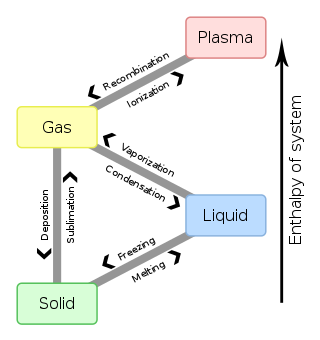String-net liquid
In condensed matter physics, a string-net is an extended object whose collective behavior has been proposed as a physical mechanism for topological order by Michael A. Levin and Xiao-Gang Wen. A particular string-net model may involve only closed loops; or networks of oriented, labeled strings obeying branching rules given by some gauge group; or still more general networks.[1]
Overview
The string-net model is claimed to show the derivation of photons, electrons, and U(1) gauge charge, small (relative to the Planck mass) but nonzero masses, and suggestions that the leptons, quarks, and gluons can be modeled in the same way. In other words, string-net condensation provides a unified origin for photons and electrons (or gauge bosons and fermions). It can be viewed as an origin of light and electron (or gauge interactions and Fermi statistics). However, their model does not account for the chiral coupling between the fermions and the SU(2) gauge bosons in the standard model.
For strings labeled by the positive integers, string-nets are the spin networks studied in loop quantum gravity. This has led to the proposal by Levin and Wen,[2] and Smolin, Markopoulou and Konopka[3] that loop quantum gravity's spin networks can give rise to the standard model of particle physics through this mechanism, along with fermi statistics and gauge interactions. To date, a rigorous derivation from LQG's spin networks to Levin and Wen's spin lattice has yet to be done, but the project to do so is called quantum graphity, and in a more recent paper, Tomasz Konopka, Fotini Markopoulou, Simone Severini argued that there are some similarities to spin networks (but not necessarily an exact equivalence) that gives rise to U(1) gauge charge and electrons in the string net mechanism.[4]
Herbertsmithite may be an example of string-net matter.[5][6]
Examples
Z2 spin liquid
Z2 spin liquid obtained using slave-particle approach may be the first theoretical example of string-net liquid.[7][8]
The toric code
The toric code is a two dimensional spin lattice that acts as a quantum error-correcting code. It is defined on a two dimensional lattice with toric boundary conditions with a spin-1/2 on each link. It can be shown that the ground state of the standard toric code Hamiltonian is an equal weight superposition of closed string states.[9] Such a ground state is an example of a string-net condensate[10] which has the same topological order as the Z2 spin liquid above.
References
- Levin, Michael A. & Xiao-Gang Wen (12 January 2005). "String-net condensation: A physical mechanism for topological phases". Physical Review B. 71 (45110): 21. arXiv:cond-mat/0404617. Bibcode:2005PhRvB..71d5110L. doi:10.1103/PhysRevB.71.045110.
- Levin, Michael; Wen, Xiao-Gang (2005). "Photons and electrons as emergent phenomena". Rev. Mod. Phys. 77: 871–879 [878]. arXiv:cond-mat/0407140. doi:10.1103/RevModPhys.77.871.
loop quantum gravity appears to be a string net condensation …
- Konopka, Tomasz; Markopoulou, Fotini; Smolin, Lee (2006). "Quantum Graphity". arXiv:hep-th/0611197.
We argue (but do not prove) that under certain conditions the spins in the system can arrange themselves in regular, lattice-like patterns at low temperatures.
- Konopka, Tomasz; Markopoulou, Fotini; Severini, Simone (May 2008). "Quantum graphity: A model of emergent locality". Phys. Rev. D. 77 (10): 19. arXiv:0801.0861. Bibcode:2008PhRvD..77j4029K. doi:10.1103/PhysRevD.77.104029.
The characterization of the string-condensed ground state is difficult but its excitations are expected to be that of a U(1) gauge theory, … The two main differences between this model and the original string-net condensation model proposed by Levin and Wen are that in the present case the background lattice is dynamical and has hexagonal rather than square plaquettes.
- Bowles, Claire. "Have researchers found a new state of matter?". Eureka Alert. Retrieved 29 January 2012.
- Merali, Zeeya (2007-03-17). "The universe is a string-net liquid". New Scientist. 193 (2595): 8–9. doi:10.1016/s0262-4079(07)60640-x. Retrieved 29 January 2012.
- Read, N.; Sachdev, Subir (1 March 1991). "Large-Nexpansion for frustrated quantum antiferromagnets". Physical Review Letters. American Physical Society (APS). 66 (13): 1773–1776. Bibcode:1991PhRvL..66.1773R. doi:10.1103/physrevlett.66.1773. ISSN 0031-9007. PMID 10043303.
- Xiao-Gang Wen, Mean Field Theory of Spin Liquid States with Finite Energy Gaps and Topological Orders, Phys. Rev. B44, 2664 (1991).
- Kitaev, Alexei, Y.; Chris Laumann (2009). "Topological phases and quantum computation". arXiv:0904.2771 [cond-mat.mes-hall].
- Morimae, Tomoyuki (2012). "Quantum computational tensor network on string-net condensate". Physical Review A. 85 (6): 062328. arXiv:1012.1000. Bibcode:2012PhRvA..85f2328M. doi:10.1103/PhysRevA.85.062328.

